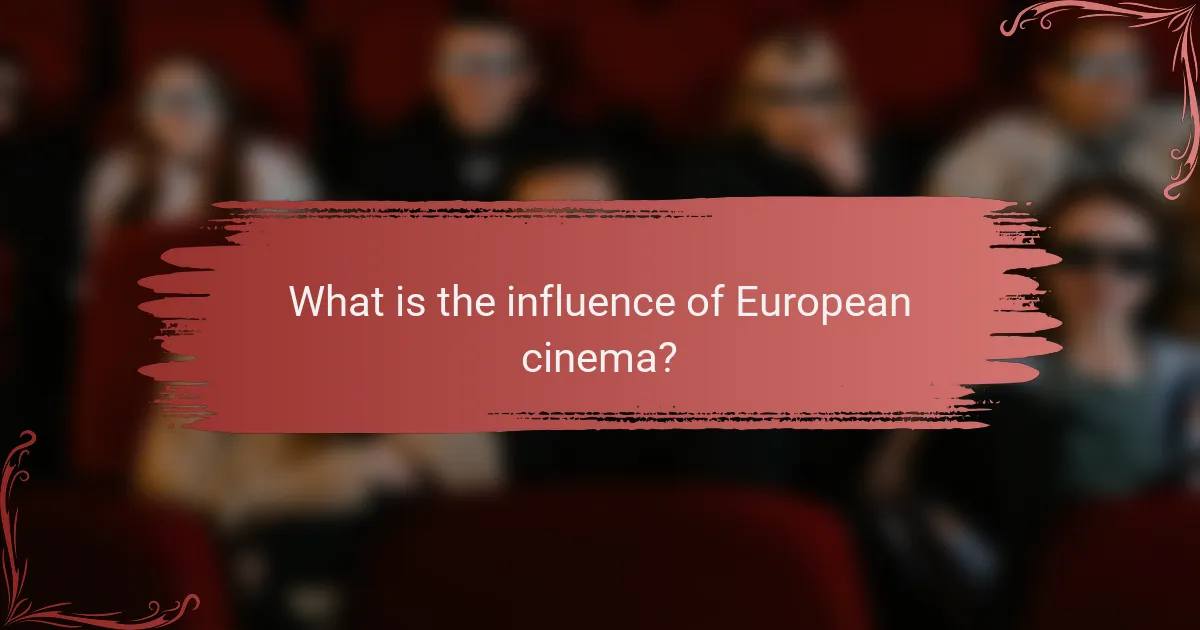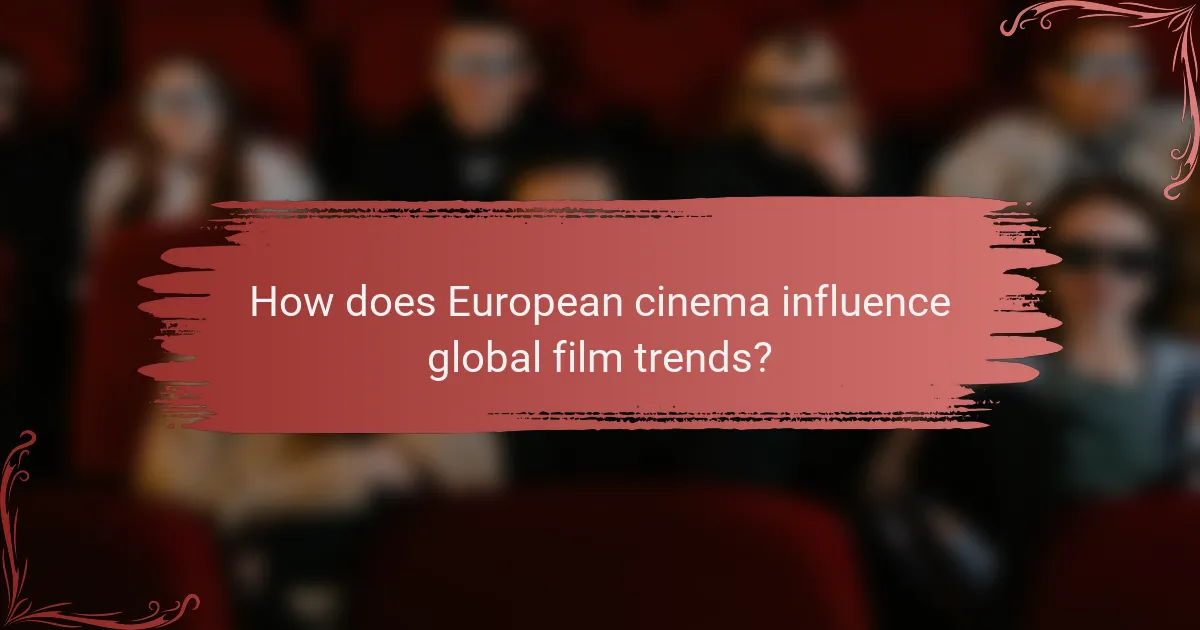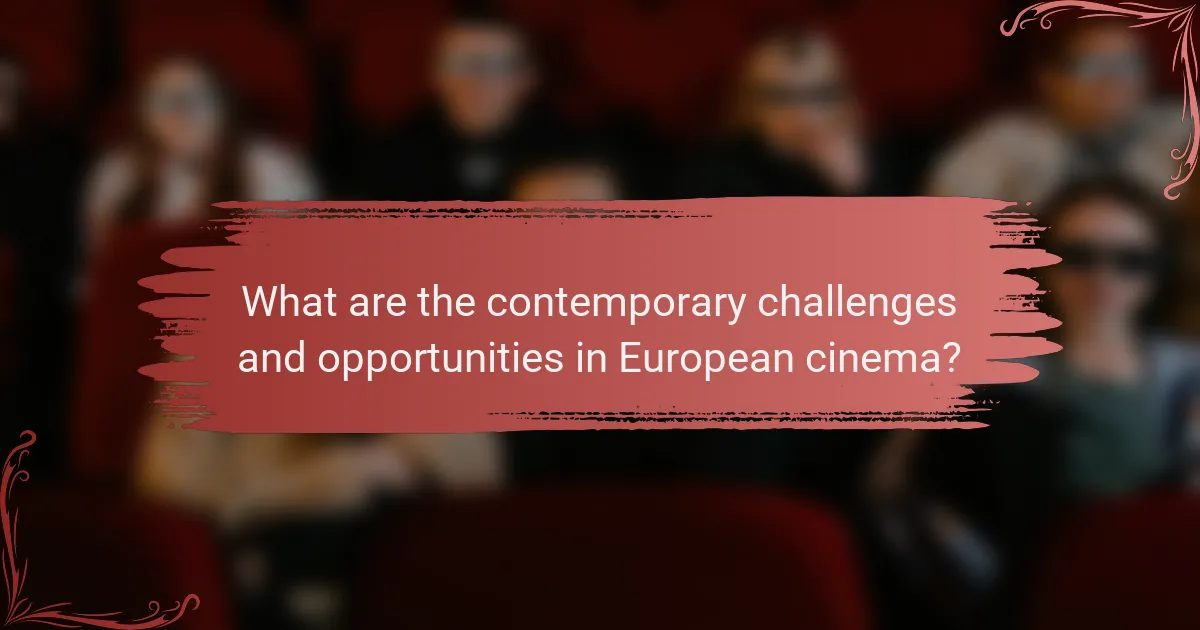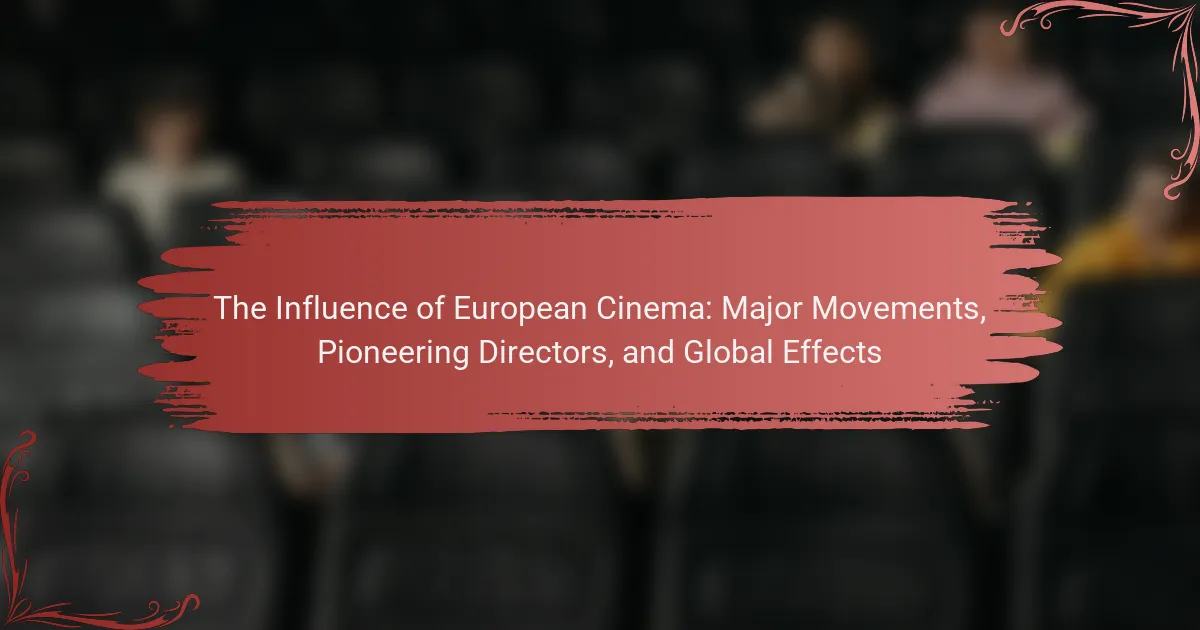European cinema serves as a significant entity in global filmmaking, characterized by its innovative storytelling and unique artistic techniques. Key movements such as Italian Neorealism and French New Wave have introduced new narrative styles that emphasize realism and personal expression, influencing filmmakers worldwide. Pioneering directors like Federico Fellini and Jean-Luc Godard have reshaped cinematic language through their distinctive approaches. While contemporary European cinema faces challenges like funding constraints and competition from streaming platforms, it also has opportunities for growth through co-productions and a rising demand for diverse narratives. The article will explore these movements, directors, and the ongoing impact of European cinema on the global film landscape.

What is the influence of European cinema?
European cinema significantly influences global filmmaking. It introduces innovative narrative techniques and diverse storytelling styles. Notable movements include Italian Neorealism, which emphasized realistic portrayals of everyday life. The French New Wave revolutionized editing and narrative structure, impacting filmmakers worldwide. Pioneering directors like Federico Fellini and Jean-Luc Godard shaped cinematic language and aesthetics. European films often explore complex themes, challenging mainstream conventions. This distinct approach inspires filmmakers in various cultures to experiment with form and content. The influence of European cinema is evident in contemporary films that incorporate its stylistic elements and thematic depth.
How has European cinema evolved over the decades?
European cinema has evolved significantly over the decades. In the early 20th century, silent films dominated, often characterized by expressionism and realism. The 1920s introduced influential movements like German Expressionism, which focused on psychological themes. The post-World War II era saw the emergence of Italian Neorealism, emphasizing social issues and everyday life. In the 1960s and 1970s, the French New Wave revolutionized narrative and style, employing innovative techniques. The 1980s and 1990s brought diverse genres and international co-productions, expanding the market. By the 21st century, digital technology transformed production and distribution, allowing for greater accessibility. Today, European cinema continues to influence global filmmaking through its artistic diversity and thematic depth.
What are the key historical milestones in European cinema?
The key historical milestones in European cinema include the Lumière brothers’ first public screening in 1895. This event marked the birth of cinema as a commercial medium. In the 1920s, German Expressionism emerged, influencing visual storytelling through films like “The Cabinet of Dr. Caligari.” The introduction of sound in the late 1920s revolutionized the industry, with “The Jazz Singer” in 1927 setting a precedent. The 1930s saw the rise of Italian Neorealism, characterized by its focus on everyday life and social issues, exemplified by “Bicycle Thieves” in 1948. The French New Wave in the late 1950s challenged traditional filmmaking conventions, with directors like François Truffaut and Jean-Luc Godard gaining prominence. The 1990s witnessed the emergence of British and Scandinavian cinema, producing acclaimed films that gained international recognition. Each of these milestones significantly shaped the evolution of European cinema and its global impact.
How have societal changes influenced European cinema?
Societal changes have significantly influenced European cinema by shaping its themes and narratives. The aftermath of World War II led to a focus on realism and human experience. This shift resulted in the emergence of neorealism in Italy, highlighting the struggles of everyday people. The 1960s counterculture movement introduced new perspectives on sexuality and politics in films. The fall of the Berlin Wall in 1989 sparked a wave of films exploring identity and reunification in Eastern Europe. Recent societal changes, such as the refugee crisis, have prompted filmmakers to address issues of migration and integration. This evolution reflects the dynamic relationship between society and cinematic expression in Europe.
What are the major movements in European cinema?
Major movements in European cinema include German Expressionism, Italian Neorealism, and French New Wave. German Expressionism emerged in the 1920s, characterized by distorted sets and emotional themes. It influenced films like “The Cabinet of Dr. Caligari.” Italian Neorealism, prominent after World War II, focused on everyday life and social issues. Films such as “Bicycle Thieves” exemplified this movement. French New Wave, starting in the late 1950s, emphasized innovative storytelling and visual techniques. Directors like François Truffaut and Jean-Luc Godard were key figures. Each movement significantly shaped global cinema, introducing new styles and narratives.
What defines the French New Wave and its impact?
The French New Wave is defined by its innovative narrative techniques and stylistic experimentation. This film movement emerged in the late 1950s and early 1960s in France. Directors like François Truffaut and Jean-Luc Godard challenged traditional filmmaking conventions. They employed jump cuts, non-linear storytelling, and location shooting. The movement emphasized personal expression and the director’s vision. Its impact reshaped global cinema by inspiring independent filmmakers. The French New Wave encouraged a focus on character-driven stories and realism. It also influenced genres such as the modern thriller and romantic comedy. The legacy of the French New Wave continues to resonate in contemporary filmmaking.
How did Italian Neorealism shape global cinema?
Italian Neorealism significantly shaped global cinema by introducing a new approach to storytelling and production. It emphasized realism, focusing on the lives of ordinary people and social issues. This movement emerged in Italy after World War II, with films like “Bicycle Thieves” and “Rome, Open City.” These films used non-professional actors and real locations, creating an authentic representation of post-war society.
The influence of Italian Neorealism can be seen in the works of directors worldwide. Filmmakers such as Satyajit Ray in India and the French New Wave directors were inspired by its techniques. The movement encouraged a shift from glamorous depictions of life to more relatable narratives. This paved the way for subsequent movements like French New Wave and independent cinema globally.
Italian Neorealism’s legacy includes its lasting impact on documentary filmmaking. Its principles of authenticity and social commentary continue to resonate in contemporary cinema. Overall, Italian Neorealism redefined cinematic language and narrative style, influencing generations of filmmakers across the globe.
What are the characteristics of German Expressionism?
German Expressionism is characterized by its focus on emotional experience over physical reality. It often employs distorted visuals to convey psychological states. The movement features stark contrasts in lighting, creating dramatic shadows. Themes of alienation and existential dread are prevalent in its works. Artists frequently used exaggerated forms and colors to express inner turmoil. The style is evident in both visual arts and cinema, influencing filmmakers like Fritz Lang and Robert Wiene. Iconic films, such as “The Cabinet of Dr. Caligari,” exemplify these characteristics. Overall, German Expressionism revolutionized artistic expression in the early 20th century.
Who are the pioneering directors of European cinema?
The pioneering directors of European cinema include Georges Méliès, F.W. Murnau, and Jean-Luc Godard. Georges Méliès is known for his innovative use of special effects and narrative storytelling. His film “A Trip to the Moon” (1902) is a landmark in cinematic history. F.W. Murnau is celebrated for his expressionist films, particularly “Nosferatu” (1922), which influenced the horror genre. Jean-Luc Godard is a key figure in the French New Wave, known for his film “Breathless” (1960), which broke traditional narrative structures. These directors significantly shaped the evolution of cinema in Europe and beyond.
What contributions did Federico Fellini make to cinema?
Federico Fellini significantly influenced cinema through his innovative storytelling and visual style. He pioneered the use of surrealism and fantasy in film. His works often blended reality with dreams, creating a unique narrative structure. Fellini’s films, such as “La Dolce Vita” and “8½,” explored themes of existentialism and the human condition. He won five Academy Awards for Best Foreign Language Film, showcasing his global impact. His distinctive aesthetic, characterized by rich imagery and elaborate set designs, set new standards in filmmaking. Fellini’s influence is evident in the works of many contemporary directors who draw inspiration from his approach to narrative and visual artistry.
How did Ingmar Bergman’s work influence storytelling in film?
Ingmar Bergman’s work significantly influenced storytelling in film by introducing complex psychological themes. He explored existential questions, faith, and the human condition. His films often featured intimate character studies and minimalistic settings. This approach allowed for deep emotional resonance. Bergman’s use of symbolism and imagery enhanced narrative depth. His storytelling techniques inspired filmmakers to prioritize character development. Directors like Woody Allen and Martin Scorsese have cited Bergman’s impact on their work. The exploration of inner turmoil in films became more prominent due to his influence. Bergman’s legacy is evident in the thematic complexity of contemporary cinema.
What is the significance of Jean-Luc Godard in modern cinema?
Jean-Luc Godard is significant in modern cinema for revolutionizing narrative and visual storytelling. His work is foundational to the French New Wave movement. Godard introduced innovative techniques such as jump cuts and breaking the fourth wall. These methods challenged traditional filmmaking conventions. His film “Breathless” (1960) is a key example of this approach. It redefined how stories could be told on screen. Godard’s influence extends beyond France, impacting filmmakers worldwide. His emphasis on political themes and personal expression resonates in contemporary cinema. Godard’s legacy continues to inspire new generations of directors and storytellers.

How does European cinema influence global film trends?
European cinema significantly influences global film trends through its innovative storytelling and artistic techniques. Notable movements such as Italian Neorealism and French New Wave introduced new narrative styles. These movements emphasized realism and personal expression, impacting filmmakers worldwide. Pioneering directors like Federico Fellini and Jean-Luc Godard inspired countless international filmmakers. Their unique approaches to character development and visual storytelling reshaped cinematic language. Furthermore, European films often tackle complex themes, encouraging a more profound exploration of human experiences. This thematic depth resonates across cultures, prompting global audiences to seek similar narratives. European cinema’s emphasis on auteur-driven projects has also led to the rise of independent film movements globally.
What are the global effects of European cinematic styles?
European cinematic styles have significantly influenced global filmmaking. They introduced innovative narrative techniques, such as nonlinear storytelling and deep character exploration. These styles emphasized artistic expression over commercial viability. European films often challenge conventional genre boundaries, inspiring filmmakers worldwide. The French New Wave, for example, revolutionized editing and camera work, affecting global cinema aesthetics. Italian neorealism highlighted social issues, prompting filmmakers to address realism in their narratives. European cinema also fostered a diverse range of genres, enriching global film culture. The impact of directors like Ingmar Bergman and Federico Fellini is evident in contemporary filmmaking. Their unique approaches continue to inspire filmmakers across various regions.
How have European filmmakers inspired Hollywood?
European filmmakers have significantly inspired Hollywood through innovative storytelling and unique cinematic techniques. Directors like Federico Fellini and Jean-Luc Godard introduced new narrative styles and visual aesthetics. Their work emphasized character-driven plots and existential themes. This influence is evident in films like “Pulp Fiction,” which draws from European art cinema’s non-linear storytelling. The French New Wave movement encouraged Hollywood to embrace more experimental approaches. Additionally, European filmmakers often tackled complex social issues, prompting Hollywood to explore deeper themes in mainstream cinema. The success of films like “The Lives of Others” has led to increased interest in international storytelling. Overall, the cross-pollination of ideas has enriched Hollywood’s creative landscape.
What role does European cinema play in international festivals?
European cinema plays a significant role in international festivals by showcasing diverse storytelling and innovative filmmaking techniques. It often sets trends that influence global cinema. Festivals like Cannes and Berlin highlight European films, attracting international audiences and critics. These events provide a platform for emerging filmmakers and established directors alike. European cinema frequently addresses social and political issues, enriching the festival landscape. The presence of European films at festivals often leads to awards and recognition, enhancing their global visibility. This influence helps shape cinematic discourse worldwide.
How do themes in European cinema resonate worldwide?
Themes in European cinema resonate worldwide through their exploration of universal human experiences. These themes include love, identity, conflict, and existentialism. For example, films like “Amélie” and “The Lives of Others” address personal and social dilemmas that many can relate to. European filmmakers often emphasize character development and emotional depth. This approach appeals to diverse audiences seeking authenticity in storytelling. Additionally, European cinema frequently challenges societal norms, prompting global conversations about culture and morality. The critical acclaim of films from festivals like Cannes and Berlin further amplifies their international reach. Such recognition encourages worldwide audiences to engage with European narratives.
What universal themes are explored in European films?
European films explore universal themes such as love, identity, conflict, and existentialism. Love is often depicted in its various forms, including romantic, familial, and platonic relationships. Identity is a recurring theme, reflecting cultural, national, and personal struggles. Conflict, both internal and external, drives many narratives, showcasing human struggles against societal norms or personal dilemmas. Existentialism is frequently examined, questioning the meaning of life and human existence. These themes resonate across cultures, making European cinema relatable to a global audience. For instance, films like “Amour” and “The Lives of Others” illustrate these themes vividly, contributing to their international acclaim.
How do cultural narratives in European cinema connect with global audiences?
Cultural narratives in European cinema connect with global audiences through universal themes and relatable human experiences. These narratives often explore complex emotions, societal issues, and moral dilemmas. For instance, films like “Amélie” and “The Lives of Others” resonate due to their focus on love, identity, and freedom. Such themes transcend cultural boundaries and appeal to diverse viewers. Additionally, European filmmakers often employ unique storytelling techniques that captivate audiences, such as non-linear narratives and character-driven plots. This distinct style enhances engagement and fosters a deeper connection. Moreover, international film festivals showcase European cinema, increasing its visibility and accessibility worldwide. This exposure facilitates cross-cultural dialogue and appreciation, further bridging gaps between European narratives and global audiences.

What are the contemporary challenges and opportunities in European cinema?
Contemporary challenges in European cinema include funding constraints, competition from streaming platforms, and audience engagement. Many filmmakers struggle to secure financing for projects. This is exacerbated by the dominance of major Hollywood studios and global streaming services. Additionally, the shift in viewing habits has led to decreased attendance in cinemas.
Opportunities arise from the growing demand for diverse storytelling and unique perspectives. European cinema can leverage its rich cultural heritage to create distinctive content. Co-productions between countries offer financial and creative benefits. Furthermore, festivals and awards can provide platforms for emerging talent.
The European Film Market reported a rise in co-productions, indicating a collaborative spirit. According to the European Audiovisual Observatory, streaming services have increased investment in original European content. These factors suggest that while challenges exist, opportunities for innovation and growth remain robust.
How is European cinema adapting to digital transformation?
European cinema is adapting to digital transformation by embracing new technologies and distribution methods. Filmmakers are utilizing digital tools for production, editing, and special effects. Streaming platforms have become crucial for reaching audiences, especially during the pandemic. Many European films are now produced with digital-first strategies in mind. This shift allows for lower production costs and faster turnaround times. Additionally, virtual film festivals have emerged, enabling broader access to international films. Audience engagement is also enhanced through social media and interactive content. Overall, European cinema is evolving to remain competitive in a rapidly changing landscape.
What new platforms are emerging for European filmmakers?
New platforms emerging for European filmmakers include MUBI, Filmin, and VOD platforms like Vimeo On Demand. MUBI offers a curated selection of films, emphasizing independent and international cinema. Filmin provides a platform tailored for Spanish-speaking audiences, showcasing local films. Vimeo On Demand allows filmmakers to distribute their work directly to audiences, enhancing visibility. These platforms support diverse storytelling and provide alternatives to traditional distribution channels. They are gaining traction as filmmakers seek innovative ways to reach viewers.
How do streaming services affect the distribution of European films?
Streaming services significantly enhance the distribution of European films. They provide wider access to diverse audiences beyond traditional cinema. Platforms like Netflix and Amazon Prime Video invest in European content. This investment helps finance productions that might struggle in conventional markets. Streaming services also allow for easier global reach. European films can now be viewed in various countries simultaneously. This accessibility increases visibility for lesser-known filmmakers. Data shows that European films have gained popularity on these platforms, leading to higher viewership numbers.
What best practices can be adopted from European cinema?
European cinema emphasizes artistic storytelling and character development. This approach often prioritizes narrative depth over commercial viability. European films frequently explore complex themes and societal issues. They utilize innovative cinematography and editing techniques to enhance visual storytelling. Collaboration among filmmakers, writers, and actors is common in European projects. This fosters a creative environment that encourages experimentation. Additionally, European cinema often supports diverse voices and perspectives. Funding models in Europe promote independent filmmaking, allowing for unique narratives. These practices contribute to a rich cinematic tradition that influences global filmmaking.
How can filmmakers leverage European cinematic techniques in their work?
Filmmakers can leverage European cinematic techniques by incorporating unique narrative styles and visual aesthetics. European cinema often emphasizes character-driven stories over plot-driven ones. This approach allows for deeper emotional connections with the audience. Techniques such as long takes and minimalistic dialogue can create a more immersive experience. Filmmakers can also explore themes of existentialism and social commentary, which are prevalent in European films. Utilizing these thematic elements can add depth to their narratives. Additionally, filmmakers can adopt innovative editing styles found in European cinema. For instance, jump cuts and non-linear storytelling can enhance the overall impact of a film. By studying influential European directors, filmmakers can gain insights into the art of visual storytelling.
What lessons can be learned from the collaborative nature of European cinema?
The collaborative nature of European cinema teaches the importance of diverse perspectives in storytelling. It highlights how filmmakers from different backgrounds can create richer narratives. European cinema often involves co-productions between countries, enhancing cultural exchange. This collaboration leads to innovative techniques and styles that influence global cinema. For example, films like “The Lives of Others” showcase how teamwork can elevate storytelling. Additionally, the success of festivals like Cannes demonstrates the value of showcasing international talent. European cinema’s collaborative spirit fosters creativity and inclusivity, offering lessons for filmmakers worldwide.
The main entity of the article is European cinema, which has a profound influence on global filmmaking through its innovative narrative techniques and diverse storytelling styles. The article outlines key historical milestones, major movements such as Italian Neorealism and French New Wave, and the contributions of pioneering directors like Federico Fellini and Jean-Luc Godard. It also examines how societal changes have shaped European cinema, the significance of its themes in connecting with global audiences, and the contemporary challenges and opportunities it faces in the digital age. Additionally, the article highlights the impact of European cinematic styles on Hollywood and the importance of international festivals in promoting European films.
